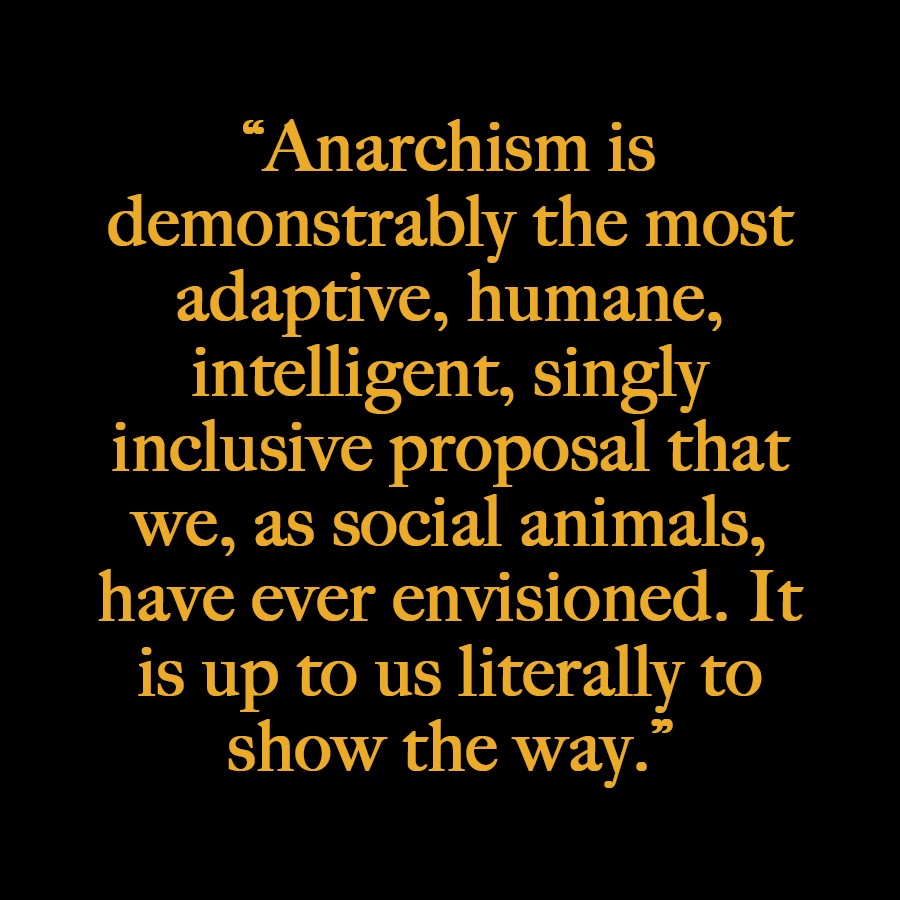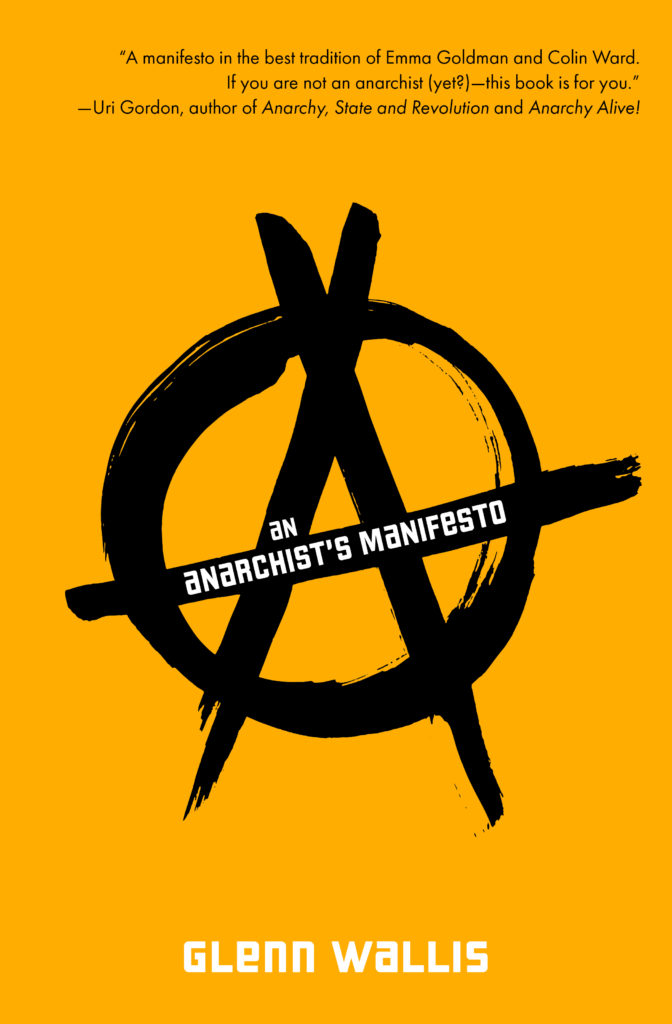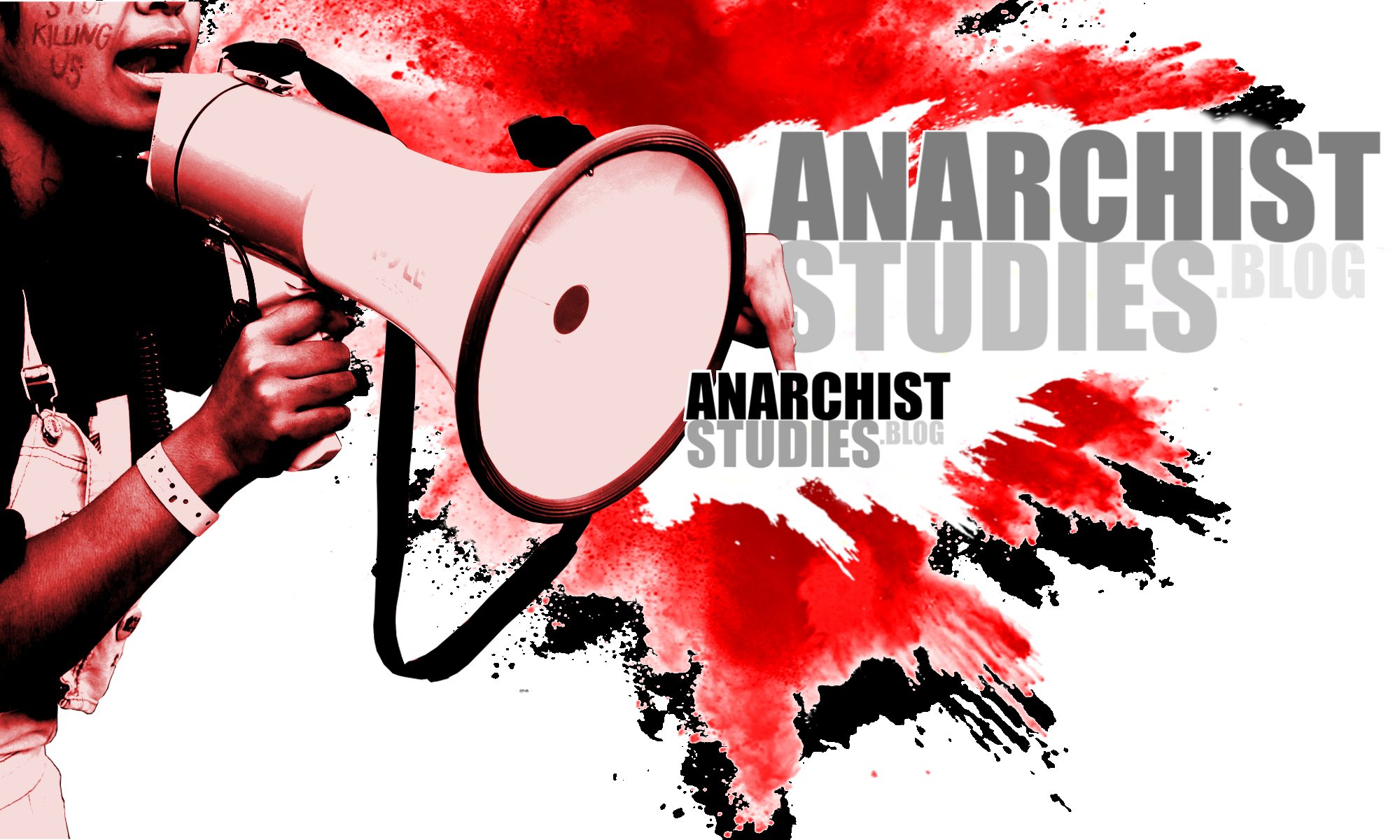by Glenn Wallis
1st May 2021

At the very root of anarchy is a simple idea: social organization without (an) a dominating figure or controller (archos). Though simple, realizing such a form in our daily lives is virtually impossible. Though virtually impossible, this idea, when pursued, is profoundly constructive. The mere removal of authority has real-world consequences that are in equal measure transformative and far-reaching, for both the individuals involved and society as a whole. That removal catalyzes an array of additional values and ways of being. I was exposed to anarchist principles in action when I attended a “free” school as a teenager. Although we did not always explicitly use the parlance of anarchist theory, my mere participation in the school exposed me, in the deepest epidemiological sense of that word, to the practices, the ways of being, that we will be exploring in this text. Once I experienced the creativity and intelligence that are unleashed through, say, mutual cooperation, I could never again value or respect top-down authority. Because of my experience, I have been perplexed that anarchism has remained so marginalized for so long. Indeed, as I learned back then, many exceptionally thoughtful and creative people who are not generally known as anarchists, or indeed who do not even identify as anarchist, have in fact argued that for humanity to have a future, or at least a future worth living, something like anarchism must become the norm. Why would they think so? More importantly, why might you come to think so? In terms of a definition, this is what I have come to understand by this simple idea.
Anarchism: A value system for organizing relations between people. It emphasizes order, cooperation, equality, and mutual support. It rejects authoritarianism, oppression, exploitation, coercion, and hierarchy.
Anarchist: A person who applies and advances the values of anarchism within micro, meso, or macro levels of interaction; that is, from partnerships and small groups to organizations, institutions, and large-scale political formations.
Anarchism is nothing if not, in the parlance of the left, a praxis. Basically, this is a German word for “practice.” However, it is useful for articulating a specific understanding of both the role of, and the relationship between, theory and practice in shaping our world. And it is very important for understanding the nature of anarchism. In its socialist sense, the concept praxis originates in Marx’s Theses on Feuerbach. These were notes that Marx jotted down as an exile in Brussels in 1845 as he was turning away from abstract idealist notions of being in the world, and toward a deeply embodied materialism. What this means exactly should become clear as we proceed. The gist of the idea is discernible from the first Thesis: “The chief defect of all hitherto existing materialism … is that the thing, reality, sensuousness, is conceived only in the form of the object of contemplation, but not as sensuous human activity, practice [German: Praxis], not subjectively.” Marx is positing that sensuous human activity is already present within the very process of “contemplation,” or indeed, in the very creation of the object or idea under consideration. The Theses want to place the primacy of praxis – our lived engagement with, and influence on, our social world – over abstraction, or mere “scholastic” approaches to the person in the world that circumvent this engagement.
People must prove the truth – i.e. the reality and power, the this-sidedness of their thinking, in practice. The dispute over the reality or non-reality of thinking that is isolated from practice is a purely scholastic question … All social life is essentially practical. All mysteries which lead theory to mysticism find their rational solution in human practice and in the comprehension of this practice … The philosophers have only interpreted the world, in various ways; the point is to change it.
Praxis thus has two facets. The first facet involves committed action in and on our social formations, and does so, moreover, on the premise that those formations already and continuously bear our shaping influence. Existing social formations are viewed not as natural and inevitable outcomes, but rather as the current result of certain complex processes, primarily historical, cultural, political, and economic in nature. The second facet assumes that theorizing different social formations is intertwined in the practical facet. Anarchist bestselling author, Ursula Le Guin (1929-2018), brought this facet to life in her National Book Award speech, in which she said: “We live in capitalism, its power seems inescapable – but then, so did the divine right of kings. Any human power can be resisted and changed by human beings. Resistance and change often begin in art.” When Marx made his famous proclamation about the philosophers in the last of the Theses, he was not asking us to forego theoretical speculation, or, indeed, art. Rather, he assumed the value and promise held out by such work. It is, however, never enough. Praxis is a useful term because it combines two interpenetrated modes of practical action that we typically hold apart: theory and practice. In short, then, praxis names the simultaneous and symbiotic relationship between theoretically-informed practical action and practice-informed theorization. It means: theory in action; action in theorizing. As Marquis Bey puts it, since:
praxis is a doing, an agential enactment that bears on sociality, then a critical praxis marks an interrogative social enactment. What kind of politics might this lead to? What kind of world might this engender, and who might show up to this promiscuous gathering?
So, again, anarchism is based on a simple proposition. Its ideal is virtually impossible to realize because of the many powerful forces that lead to and perpetuate the status quo, the current state of affairs (indistinguishable from the affairs of the state). Anarchist praxis is nonetheless profoundly constructive because in acting on the world with its values, we give shape, to whatever extent, to a new world. It is important to keep this point in mind. For one thing, it puts the lie to the common reputation of anarchism as a starry-eyed utopianism. As a praxis, anarchism is nothing if not a committed and often impassioned experimentation, in thought and action, concerning better ways of living together. More importantly, this point puts the onus on everyone who sees the value here to actualize, to whatever extent they are able, the forms of organization they want to see manifest in the world. Anarchism, that is to say, is a set of ideas with which to do something. Even more to the point, anarchism is something that is done. As Albert Meltzer (1920-1996) insists, anarchism is “a creed that has been worked out in practice rather than from a philosophy.”

Before we move on, we should further consider this notion of extent. This is actually a somewhat vexed issue in anarchist discourse. A brief discussion here should help you in imagining how you might employ anarchist ideas.
For anarchism to be realized, must it occur at the macro level of what we call nations and states? Much anarchist thought seems to assume so. This strand of thought often reads like political science, offering a theory of the (stateless) state on a grand scale. It concerns itself with uppercase Society. Errico Malatesta’s (1853-1932) “The Anarchist Revolution” is pervaded by this spirit of total revolution.
The revolution is the creation of new living institutions, new groupings, new social relationships; it is the destruction of privileges and monopolies. Revolution is the organization of all public services by those who work in them in their own interest as well as the public’s. Revolution is the forming and disbanding of thousands of representative, district, communal, regional, national bodies … Anarchy cannot be achieved until after the revolution, which will sweep away the first material obstacles.
Macro-scale anarchism often includes detailed descriptions of how things will look “under anarchism.” It is this proclivity to think through eminently practical matters like money, organization and governance, work and industry, transportation, technology, and so on ad infinitum, that contributes to anarchism’s reputation as a dreamy utopianism. And yet, is it not reasonable to conclude that until we replace the demonstrably unjust systems of organization that make up our world nothing of consequence will ever change? Some anarchists see that as an unreasonable assertion. Even the fiery Malatesta ends his call to total revolution with these words: “If we are unable to overthrow capitalism, we shall have to demand for ourselves and for all who want it, the right of free access to the necessary means of production to maintain an independent existence.” Does “The Anarchist Revolution” end with a submissive flinch?
So, maybe it is enough to realize anarchist ideals at the micro level of personal relations and lowercase society. Socialist historian Howard Zinn cautioned against the “grand, heroic actions” that many anarchists associate with macro revolutionary social praxis.
Revolutionary change does not come as one cataclysmic moment … but as an endless succession of surprises, moving zigzag toward a more perfect society. We don’t have to engage in grand, heroic actions to participate in the process of change. Small acts, when multiplied by millions of people, can transform the world.
If we take a sober assessment of the inconceivably gargantuan mobilization of people, power, and material resources required to achieve anything resembling a “revolution,” do we not arrive at a similar conclusion? Even a dyed-in-the-wool communist like Slavoj Žižek (or was it Marxist theorist Fredric Jameson?) can proclaim, “it is easier to imagine an end to the world than an end to capitalism.” Many leftist thinkers today, in fact, express a similar resignation toward what they view as the vampiric, zombie-like capacities of capitalism, and all of the accompanying political, cultural, and economic modes of life encapsulated in that term. Adapting a term used by German pop artists in the 1960s to parody socialist realism, Mark Fisher names this phenomenon “capitalist realism.” This is “the widespread sense that not only is capitalism the only viable political and economic system, but also that it is now impossible even to imagine a coherent alternative to it.” The reason for our failure of imagination is that capitalism appears so fundamentally necessary, natural, and inevitable that we lose sight of the fact that it is, like Ursula Le Guin’s divine right of kings, a wholly contingent affair. It is, says Fisher,
more like a pervasive atmosphere, conditioning not only the production of culture but also the regulation of work and education, and acting as a kind of invisible barrier constraining thought and action.
Like the Golem of medieval Jewish lore, capitalism is a deaf and dumb beast fashioned from the dust – created by humans – that eventually comes to terrorize its mesmerized makers. Rabbi Zeira was acting as an insurgent anarchist when he confronted the Golem, bellowing, “You were created by the sages; return to your dust!”
But, of course, in real life, the Golem does not return to its dust at our command. If anything, the massive structures of oppression that macro-oriented anarchists intend to destroy only harden over time. In fact, as a recent Monmouth University poll on Americans’ views on socialism vs. capitalism indicate, those ostensibly oppressive structures resolutely retain their popularity over time. So, to some anarchists, Zinn’s “small acts” strategy amounts to a resignation or surrender. Some have rendered even harsher judgements. Murray Bookchin (1921-2006) derisively called this phenomenon “lifestyle anarchism.” He contends that anarchists have failed in their efforts at macro change largely because “thousands of self-styled anarchists have slowly surrendered the social core of anarchist ideas to the all-pervasive Yuppie and New Age personalism that marks this decadent, bourgeoisified era.” And by “personalism,” Bookchin means the individual-preference motivated “small acts” of Zinn’s statement. To other anarchists, the “small acts” argument amounts to magical thinking. What guarantee is there that anyone, much less “millions of people,” will join my efforts? And even if they do, history predicts that the state would eventually intervene to quash it, and capitalism would find a way to co-opt, commodify, and depotentialize it. Hence, argue the macroists, the necessity for total revolution, which, by definition, dismantles the overarching oppressive infrastructure – the state and capitalism – itself. To which the chorus solemnly intones: That is just not possible. And around and around we go.
Finally, the “extent” of application for anarchist principles might occur at the meso level of social organization. I understand the two complementary principles of prefiguration and concrete utopia to be models for this meso level anarchism. These ideas are encapsulated in the motto of the Industrial Workers of the World (IWW), the revolutionary international labor union known as the Wobblies: “building the new society in the shell of the old.” Urban planner, architect, and eminently practical anarchist theorist, Colin Ward (1924-2010), echoes this contention in his often-cited insistence that “If you want to build a free society, the parts are all at hand.” Traditionally, this approach calls for praxis within the existing institutions of our social life, such as schools, neighborhood assemblies, businesses, universities, and so on. More recently it has also come to mean the creation of new formations of the same, often called “counter-institutions.” The assumption is that prefiguration entails the very “embodiment, within the ongoing political practice of a movement, of those forms of social relations, decision-making, culture, and human experience that are the ultimate goal.” If the “small acts” approach is, as a popular meme puts it, “being the change you wish to see,” prefiguration is “building the models you wish to see,” creating the school, business, organization that you wish to see emulated and proliferated in the world. As political scientist Carl Boggs, who popularized this usage of the term in 1977, says of prefiguration:
Only popular institutions in every sphere of daily existence, where democratic impulses can be most completely realized, can fight off the repressive incursions of bureaucratic centralism and activate collective involvement that is the life-force of revolutionary practice.
At this meso-level, anarchist society originates in the very doing of anarchism in, moreover, the very places where individuals form into community. Macro-level anarchists, with a vigilant eye on class struggle and total revolution, might accuse this approach of being a “nonviolent, bourgeois, sanitized anarchism,” but if anarchists want to get anywhere with skeptical liberals, say, won’t we have to take that risk? I believe that the “life-force” of anarchism may manifest either in micro-level personal ethics, meso-level organizational modeling, macro-level political agitation, or in some combination of these locations. It is precisely its location in the very “sensuousness” of our continuously unfolding lived experience, private and communal, that makes anarchism such a compelling and imperative proposition. Indeed, anarchism is demonstrably the most adaptive, humane, intelligent, singly inclusive proposal that we, as social animals, have ever envisioned. It is up to us literally to show the way.

[This article is an excerpt from An Anarchist’s Manifesto by Glenn Wallis, now available on Warbler Press. Glenn is the founder of Incite Seminars, an anarchist-inspired educational project].
